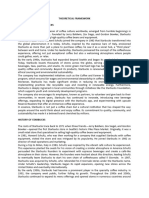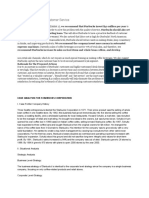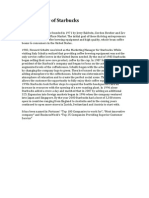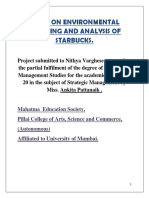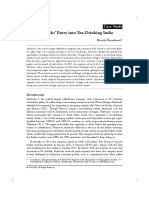Untitled Document
Untitled Document
Uploaded by
nikki.gonoCopyright:
Available Formats
Untitled Document
Untitled Document
Uploaded by
nikki.gonoOriginal Title
Copyright
Available Formats
Share this document
Did you find this document useful?
Is this content inappropriate?
Copyright:
Available Formats
Untitled Document
Untitled Document
Uploaded by
nikki.gonoCopyright:
Available Formats
Sure!
Let's dive into a discussion about Starbucks, covering various aspects such as its history,
business model, global presence, and impact on the coffee culture.
History of Starbucks
Starbucks was founded in 1971 in Seattle, Washington, by three partners: Jerry Baldwin, Zev
Siegl, and Gordon Bowker. Initially, Starbucks was a single store that sold high-quality coffee
beans and equipment. The company got its name from the first mate in Herman Melville's
Moby-Dick, reflecting the maritime culture of Seattle.
In the early 1980s, Howard Schultz joined Starbucks and later convinced the founders to
experiment with selling espresso beverages. After a trip to Italy, Schultz was inspired by the
Italian coffee culture and envisioned creating a similar environment in the United States. In
1987, Schultz bought the company and began expanding Starbucks, focusing on creating a
unique coffee experience.
Business Model
Starbucks' business model is based on providing a premium coffee experience. Key
components of its business model include:
1. Product Quality: Starbucks emphasizes high-quality coffee beans sourced from ethical
and sustainable suppliers.
2. Customer Experience: The company aims to create a "third place" between home and
work where customers can relax and enjoy their coffee.
3. Innovation: Starbucks continuously innovates its product offerings, including seasonal
drinks, food items, and merchandise.
4. Global Expansion: Starbucks has expanded globally, with thousands of stores in
various countries, adapting to local tastes while maintaining its core brand identity.
5. Technology Integration: Starbucks has embraced technology with initiatives like the
Starbucks app, mobile ordering, and a loyalty program to enhance customer
convenience and engagement.
Global Presence
Starbucks has a significant global presence, with over 30,000 stores in more than 80 countries.
The company's international expansion strategy involves both company-operated stores and
licensed stores. Key markets include the United States, China, Japan, and Canada. Starbucks
has tailored its menu and store design to cater to local preferences in different regions.
Impact on Coffee Culture
Starbucks has had a profound impact on coffee culture worldwide:
1. Popularizing Specialty Coffee: Starbucks played a crucial role in popularizing specialty
coffee and making espresso-based drinks widely available.
2. Changing Consumption Habits: The company introduced the concept of the
coffeehouse as a social and work space, influencing how people consume coffee.
3. Ethical Sourcing: Starbucks has promoted ethical sourcing practices through its Coffee
and Farmer Equity (C.A.F.E.) Practices program, supporting sustainable farming.
4. Community Engagement: Starbucks engages with local communities through various
initiatives, including environmental sustainability efforts and support for social causes.
Challenges and Criticisms
Despite its success, Starbucks faces several challenges and criticisms:
1. Market Saturation: In some regions, Starbucks faces market saturation, leading to
slowing growth.
2. Competition: The company faces intense competition from other coffee chains,
independent coffee shops, and fast-food outlets offering premium coffee.
3. Labor Practices: Starbucks has faced criticism over labor practices, including issues
related to wages, working conditions, and unionization efforts.
4. Environmental Impact: The company has been criticized for its environmental impact,
particularly regarding single-use cups and waste.
Future Outlook
Starbucks continues to evolve, focusing on digital innovation, expanding its presence in
emerging markets, and enhancing its sustainability efforts. The company aims to reduce its
environmental footprint, improve its supply chain sustainability, and contribute positively to the
communities it serves.
This comprehensive overview captures the essence of Starbucks' journey, its business
strategies, and its influence on global coffee culture. If you have any specific areas you'd like to
delve into further, feel free to let me know!
You might also like
- Contract To Sell-Motor VehicleDocument3 pagesContract To Sell-Motor VehicleQueenie Mangubat-Gomez71% (34)
- Marketing Communications Touchpoints, Sharing and Disruption, 8th Edition (Great For Case Studies)Document804 pagesMarketing Communications Touchpoints, Sharing and Disruption, 8th Edition (Great For Case Studies)Linh LinhNo ratings yet
- Management Information System (MIS) - StarbucksDocument10 pagesManagement Information System (MIS) - StarbucksManisha Jain100% (7)
- Starbucks Report - Business Research MethodologyDocument80 pagesStarbucks Report - Business Research MethodologyRaveena Balani70% (20)
- Zhang 2017Document5 pagesZhang 2017Gaurav MittalNo ratings yet
- Starbucks Case StudyDocument20 pagesStarbucks Case StudyTASYA100% (3)
- SCM201 - Group Assignment - StarbucksDocument15 pagesSCM201 - Group Assignment - StarbucksTruong Dinh Phu (K14 HCM)100% (1)
- Case Study 1: The Globalization of StarbucksDocument3 pagesCase Study 1: The Globalization of StarbucksYumi Okazaki100% (1)
- Starbucks Case AnalysisDocument16 pagesStarbucks Case AnalysisLô So Cool100% (1)
- C05 - Starbucks - Staying Local While Going Global Through Marketing ResearchDocument2 pagesC05 - Starbucks - Staying Local While Going Global Through Marketing ResearchSafowanNo ratings yet
- SOM CH 2 Problems SolvedDocument3 pagesSOM CH 2 Problems Solvedlubna2627100% (3)
- StarbucksDocument4 pagesStarbucksJohnryx EvangelistaNo ratings yet
- DocumentDocument1 pageDocumentmaeclara795No ratings yet
- STARBUCKSDocument11 pagesSTARBUCKSbhelhyn05No ratings yet
- IstarbucksDocument4 pagesIstarbuckssainadhaditya14No ratings yet
- Most FNLZD KanzDocument26 pagesMost FNLZD Kanzganesha puriNo ratings yet
- TM 57859606162Document8 pagesTM 57859606162deeps070304No ratings yet
- Case Study AnalysisDocument9 pagesCase Study AnalysisK IdolsNo ratings yet
- Starbucks CSRDocument15 pagesStarbucks CSRKaviya KaviNo ratings yet
- Starbucks HistoryDocument2 pagesStarbucks Historysawyerrex26No ratings yet
- An Overview of StarbucksDocument16 pagesAn Overview of StarbucksJaredd SubaganNo ratings yet
- An Overview of StarbucksDocument16 pagesAn Overview of StarbucksJaredd SubaganNo ratings yet
- Châu Nguyễn Anh Nghi_050610221124_L28Document4 pagesChâu Nguyễn Anh Nghi_050610221124_L28chaunguyenanhnghi.enactusbuNo ratings yet
- MIS StarbucksDocument13 pagesMIS StarbucksSabtain Syed100% (2)
- Starbucks Case StudyDocument15 pagesStarbucks Case Studyxtgeronaga100% (1)
- SWOT and PEST AnalysesDocument9 pagesSWOT and PEST AnalysesDaniel Kristoff De jesusNo ratings yet
- Starbucks CaseDocument10 pagesStarbucks CaseTr'sMax0% (1)
- Aldis Moch Sajawandi - Mid. Exam EntrepreneurshipDocument6 pagesAldis Moch Sajawandi - Mid. Exam EntrepreneurshipAldis Moch SajawandiNo ratings yet
- Case StudyDocument19 pagesCase StudyparmarpayalNo ratings yet
- Becoming An International Brand: A Case Study of StarbucksDocument11 pagesBecoming An International Brand: A Case Study of StarbuckstommyNo ratings yet
- Case Analysis For Starbucks CorporationDocument9 pagesCase Analysis For Starbucks Corporationvalentine1218No ratings yet
- Case Analysis of StarbucksDocument10 pagesCase Analysis of StarbucksJamaila Ivy D. MirasNo ratings yet
- Starbucks International Marketing StrategyDocument9 pagesStarbucks International Marketing StrategyKrishna NaNo ratings yet
- StarbucksDocument11 pagesStarbucksabu.sakibNo ratings yet
- Topic 05 CaseDocument2 pagesTopic 05 Caseaminath azzaNo ratings yet
- Starbucks - CSR: Submitted By: Sania Kiran SP18-RBA-004Document9 pagesStarbucks - CSR: Submitted By: Sania Kiran SP18-RBA-004Sumbal JameelNo ratings yet
- Assignment 1 (Starbucks)Document9 pagesAssignment 1 (Starbucks)Mannat ShrivastavaNo ratings yet
- Minimalist Annual ReportDocument12 pagesMinimalist Annual ReportMannat ShrivastavaNo ratings yet
- Case Study - StarbucksDocument11 pagesCase Study - StarbucksOcfemia, Sheena Mae RomualdoNo ratings yet
- History of StarbucksDocument10 pagesHistory of StarbucksSundus ButtNo ratings yet
- (Put A Check Mark in The Box) - Revision - RedefenseDocument9 pages(Put A Check Mark in The Box) - Revision - RedefensePATRICIA NICOLE DIZONNo ratings yet
- Assignment 1 (Case Study)Document11 pagesAssignment 1 (Case Study)Mannat ShrivastavaNo ratings yet
- Brief History of StarbucksDocument16 pagesBrief History of StarbuckstatianaodeanNo ratings yet
- (PDF) Starbucks GroupDocument17 pages(PDF) Starbucks GroupTrung Tròn Trịa100% (2)
- StarbucksDocument12 pagesStarbucksmarktolentinoNo ratings yet
- Starbucks Case StudyDocument10 pagesStarbucks Case StudyJessica Velasco SantosNo ratings yet
- Star BucksDocument24 pagesStar BucksROHIT JAINNo ratings yet
- starbucksRT Case StudyDocument2 pagesstarbucksRT Case Studyalwinx15No ratings yet
- Marketing Plan For Starbucks Robinsons Place AntipoloDocument18 pagesMarketing Plan For Starbucks Robinsons Place AntipoloDanica Castro100% (1)
- ICB StarbucksDocument6 pagesICB StarbucksMounika ChandraNo ratings yet
- Starbucks CASE STUDYDocument28 pagesStarbucks CASE STUDYrishavpal746No ratings yet
- Starbucks Brewing SuccessDocument14 pagesStarbucks Brewing Successlemuel john rodriguez carranzaNo ratings yet
- Study On Environmental Scanning and Analysis of StarbucksDocument26 pagesStudy On Environmental Scanning and Analysis of StarbucksankitaNo ratings yet
- Chiến lược marketingDocument24 pagesChiến lược marketing44 - Nguyễn Thị Phương NhungNo ratings yet
- The Success Story of StarbucksDocument15 pagesThe Success Story of StarbucksRohan Panda100% (2)
- MarketingDocument12 pagesMarketingAnonymous DepxchexNo ratings yet
- Brewing Success: A Starbucks Revolution on the Experience & TechnoinnovationFrom EverandBrewing Success: A Starbucks Revolution on the Experience & TechnoinnovationNo ratings yet
- Starbucks Globalization StrategiesDocument7 pagesStarbucks Globalization StrategiesSajid Ali MaariNo ratings yet
- Starbucks Study CaseDocument6 pagesStarbucks Study CaseRachel BorderieuxNo ratings yet
- Starbucks Case StudyDocument3 pagesStarbucks Case Studykumail zaidiNo ratings yet
- 111807909Document15 pages111807909mubarak100% (1)
- Starbucks Case StudyDocument5 pagesStarbucks Case StudyPrunella YapNo ratings yet
- Brewing Success: The Essential Guide to Starting a Coffee Shop in 2023From EverandBrewing Success: The Essential Guide to Starting a Coffee Shop in 2023No ratings yet
- Obtaining A List All Window HandlesDocument5 pagesObtaining A List All Window HandlesYamini ShindeNo ratings yet
- FUTABA Standard Plastic Mold ComponentDocument832 pagesFUTABA Standard Plastic Mold ComponentNguyen Van Ly100% (1)
- Introduction To Numerical ControlDocument17 pagesIntroduction To Numerical ControlHaris SetiawanNo ratings yet
- Remove UnitDocument4 pagesRemove Unitsy_ghiedhNo ratings yet
- Ebsco Ebook Content & Delivery - Guidelines in Brief: When To Deliver FilesDocument16 pagesEbsco Ebook Content & Delivery - Guidelines in Brief: When To Deliver FilesAndrés Trujillo MateusNo ratings yet
- PHB 4Document48 pagesPHB 4Samir Morales CadilloNo ratings yet
- DG Authorization ToDocument8 pagesDG Authorization ToRajiv SinghNo ratings yet
- Mix Design 6000 PsiDocument2 pagesMix Design 6000 PsiraheelNo ratings yet
- Datasheet 2vs3-06 Ha5051 en Flow Check ValveDocument2 pagesDatasheet 2vs3-06 Ha5051 en Flow Check ValvePritesh KoratNo ratings yet
- H 046 010879 00 BeneVision CMS Operators Manual R3 9.0Document182 pagesH 046 010879 00 BeneVision CMS Operators Manual R3 9.0rahim iqbalNo ratings yet
- NSN Irancell - Flexi EDGE - PresenttaionDocument17 pagesNSN Irancell - Flexi EDGE - PresenttaionFereidoun SadrNo ratings yet
- Centre Wise CPI IW DEC 2023Document1 pageCentre Wise CPI IW DEC 2023Jandu MaharashtraNo ratings yet
- IATF 16949 - 2016 ITALIANO - Da SitoDocument22 pagesIATF 16949 - 2016 ITALIANO - Da Sitolucaturra69No ratings yet
- 5S Check SheetDocument7 pages5S Check Sheetsunil patilNo ratings yet
- Thesis 17 Wordpress ThemeDocument6 pagesThesis 17 Wordpress Themejillcrawfordbaltimore100% (2)
- BAEEP3 - Teaching Timetable2023-11!09!201158Document2 pagesBAEEP3 - Teaching Timetable2023-11!09!201158theresiamosha69No ratings yet
- UdbsqlrefDocument1,050 pagesUdbsqlrefvangappan2No ratings yet
- Mcob 1st ModuleDocument33 pagesMcob 1st ModuleAarcha SreedevNo ratings yet
- Nift PDFDocument9 pagesNift PDFMohamed HashirNo ratings yet
- Company Profile Security Cleaning Service PT. Garuda Satria ManunggalDocument12 pagesCompany Profile Security Cleaning Service PT. Garuda Satria ManunggalHandojo SuciptoNo ratings yet
- Document of Prepaid Energy Meter Using GSMDocument1 pageDocument of Prepaid Energy Meter Using GSMeshwarp sysargusNo ratings yet
- Tenancy & Recovery of Premises in Ghana The Rent Act's Ejectment Policy.Document9 pagesTenancy & Recovery of Premises in Ghana The Rent Act's Ejectment Policy.ptabiriNo ratings yet
- Aircraft Fabric CoveringDocument19 pagesAircraft Fabric CoveringNik Lagahit100% (1)
- Abad Santos & Associates and Sycip, Salazar, Hernandez & Gatmaitan For Petitioner. Roco, Bunag, Kapunan Law Office For Private RespondentDocument11 pagesAbad Santos & Associates and Sycip, Salazar, Hernandez & Gatmaitan For Petitioner. Roco, Bunag, Kapunan Law Office For Private Respondentgerlie22No ratings yet
- 2011-Uconnect Touch User ManualDocument129 pages2011-Uconnect Touch User ManualsergiojgsNo ratings yet
- Save As Tes Application Last Name of Applicant Send Word File To Our Email or FB Page EmailDocument2 pagesSave As Tes Application Last Name of Applicant Send Word File To Our Email or FB Page EmailckNo ratings yet














